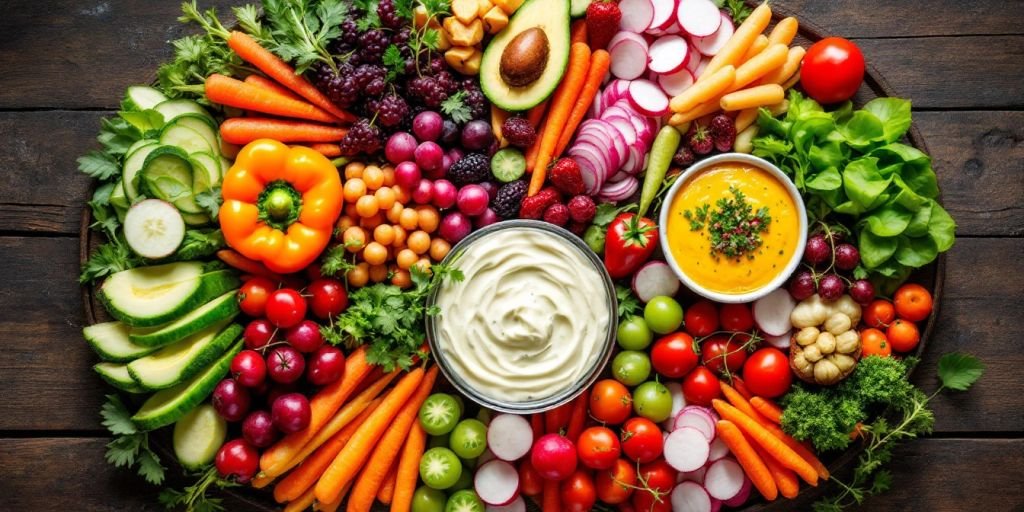
Creating a beautiful crudité platter is not only fun but also a great way to impress your guests at any gathering. With some careful planning and simple techniques, you can prepare a colorful and delicious display of fresh vegetables that everyone will love. Here are some key takeaways to help you craft the perfect veggie tray.
Key Takeaways
- Choose seasonal and fresh vegetables for the best taste.
- Mix different colors and textures to make your platter visually appealing.
- Blanch fibrous vegetables to enhance their flavor and tenderness.
- Select a variety of dips to cater to different tastes and diets.
- Keep your veggies chilled until serving to maintain their crispness.
Choosing the Right Vegetables for Your Crudité Platter
Creating a beautiful crudité platter starts with selecting the right vegetables. Freshness is essential for a vibrant and tasty display. Here are some tips to help you choose the best veggies:
Seasonal Vegetable Selection
- Always opt for vegetables that are in season. This not only ensures better flavor but also supports local farmers.
- Some great seasonal choices include:
- Spring: Asparagus, snap peas, and radishes.
- Summer: Cucumbers, bell peppers, and cherry tomatoes.
- Fall: Carrots, cauliflower, and Brussels sprouts.
Color and Texture Variety
- Aim for a mix of colors and textures to make your platter visually appealing. A colorful platter is more inviting!
- Consider including:
- Crunchy options like carrots and celery.
- Soft choices like cherry tomatoes and cucumbers.
- Unique textures such as radishes and mini bell peppers.
Freshness and Quality Tips
- Look for vegetables that are firm and free from blemishes. Heaviness often indicates freshness.
- If possible, buy from local farmers’ markets where you can find the freshest produce.
- Remember, the quality of your vegetables can make or break your platter. For instance, using fresh ingredients can elevate a simple dish like cioppino when served alongside your crudité.
Tip: Always wash your vegetables thoroughly and dry them well before arranging them on your platter to maintain their crispness.
Prepping Your Vegetables for Maximum Flavor

Blanching Techniques
Blanching is a great way to enhance the flavor and texture of your vegetables. Here’s how to do it:
- Boil water in a large pot and add a pinch of salt.
- Prepare an ice bath by filling a bowl with ice and cold water.
- Add your vegetables to the boiling water for about 1-2 minutes.
- Transfer them immediately to the ice bath to stop the cooking process.
This method not only makes veggies tender but also keeps their vibrant colors.
Cutting and Slicing Tips
When prepping your vegetables, consider these tips:
- Cut uniformly to ensure even cooking and a neat presentation.
- Leave some greens on carrots and radishes for added texture.
- Slice at an angle for a more appealing look.
Storing Prepped Vegetables
To keep your veggies fresh:
- Store them in a sealed container with a damp paper towel to maintain moisture.
- Keep them in the refrigerator and use within 2-3 days for the best flavor.
- Refresh limp vegetables by dunking them in ice water for 1-2 minutes!
Remember: Freshness is key for maximum flavor. Choose seasonal vegetables for the best taste!
Creating a Visually Stunning Crudité Platter
Arranging Vegetables for Visual Appeal
To make your crudité platter stand out, focus on color and shape. Here are some tips:
- Use a variety of colors like red bell peppers, orange carrots, and green cucumbers.
- Arrange vegetables in groups or clusters to create a more inviting look.
- Consider using different heights by stacking some veggies or using small bowls for dips.
Using Garnishes and Edible Flowers
Adding garnishes can elevate your platter. Here are some ideas:
- Use fresh herbs like parsley or dill for a pop of green.
- Incorporate edible flowers for a touch of elegance.
- Sprinkle some roasted chickpeas for added texture and flavor.
Building Height and Dimension
Creating height adds interest to your platter. Here’s how:
- Use small bowls for dips to create levels.
- Stack veggies like mini bell peppers or cucumbers on top of each other.
- Place taller vegetables like asparagus or celery at the back of the platter.
A well-arranged crudité platter not only looks appealing but also invites guests to enjoy the fresh flavors. Remember, the presentation is key!
Pairing Dips and Sauces with Your Crudité
Popular Dip Options
When it comes to dips, variety is key! Here are some popular choices:
- Hummus: A classic that pairs well with almost any veggie.
- Tzatziki: This yogurt-based dip adds a refreshing touch.
- Guacamole: Creamy and delicious, it’s a crowd favorite.
- Beer Cheese Dip: This crowd-pleasing dip is perfect as a game day snack and/or appetizer for fall festivities. Pair it with my crudité platter, pretzel board, meatball board, …
Homemade vs. Store-Bought Dips
You can choose between homemade and store-bought dips. Here are some tips:
- Homemade Dips: They can be healthier and tailored to your taste.
- Store-Bought Dips: Convenient and often delicious. Just transfer them to a nice bowl for a better presentation.
- Mix and Match: Combining both types can create a fun variety.
Garnishing Your Dips
Adding garnishes can elevate your dips:
- Fresh herbs like parsley or cilantro.
- A sprinkle of paprika or chili flakes for color.
- A drizzle of olive oil for richness.
Remember, the right dip can make your crudité platter shine! Experiment with flavors to find your favorites.
Serving and Maintaining Freshness

Keeping Vegetables Crisp
To keep your veggies fresh and crunchy, cover them with damp paper towels and store them in the refrigerator. This method helps maintain moisture and prevents them from wilting. Here are some tips:
- Store in a shallow container with a damp cloth.
- Use ice water to refresh limp vegetables.
- Avoid overcrowding to allow air circulation.
Serving Tips for Parties
When serving your crudité platter at gatherings, presentation is key! Here are some ideas:
- Arrange vegetables in groups by color for a vibrant look.
- Use small bowls for dips to create a focal point.
- Add garnishes like herbs or edible flowers for extra flair.
Storing Leftovers Properly
If you have leftover veggies, store them correctly to keep them fresh:
- Place in a sealed container with a damp paper towel.
- Keep in the fridge and consume within 2-3 days.
- Avoid mixing different types of vegetables to maintain their individual freshness.
Remember, keeping the vegetables covered and chilled until serving is essential for a picture-perfect platter!
Adding Extra Touches to Elevate Your Platter

Incorporating Fruits and Nuts
Adding fruits and nuts can bring a delightful twist to your crudité platter. Here are some ideas:
- Fruits: Include grapes, apple slices, or berries for a sweet contrast.
- Nuts: Almonds, walnuts, or pistachios add crunch and flavor.
- Dried fruits like apricots or cranberries can also enhance the taste.
Using Cheese and Crackers
Cheese and crackers can make your platter more filling and appealing. Consider these options:
- Cheese: Choose a variety like cheddar, brie, or goat cheese.
- Crackers: Offer different types, such as whole grain, gluten-free, or flavored.
- Pairing: Match cheese with specific veggies for a unique taste experience.
Adding Marinated Vegetables and Olives
Marinated vegetables and olives can add depth to your platter. Here’s how:
- Marinated Veggies: Try artichokes, roasted red peppers, or pickled cucumbers.
- Olives: Castelvetrano or Kalamata olives can provide a salty kick.
- Presentation: Use small bowls to keep these items separate and visually appealing.
Remember, a well-rounded platter not only looks good but also offers a variety of flavors and textures.
By incorporating these extra touches, you can create a crudité platter that is not only beautiful but also delicious and satisfying. Forget charcuterie boards; elevate your veggie spread to impress your guests!
Theme Ideas for Special Occasions

Creating a crudité platter can be a fun way to celebrate special occasions. Here are some ideas to make your veggie display stand out:
Holiday-Themed Platters
- Christmas: Use red and green veggies like cherry tomatoes and cucumbers. Add festive dips in holiday colors.
- Halloween: Carve veggies into spooky shapes or use black olives to create a creepy design.
- Thanksgiving: Incorporate seasonal vegetables like roasted Brussels sprouts and sweet potatoes for a fall touch.
Seasonal Themes
- Spring: Use fresh, bright vegetables like snap peas, radishes, and baby carrots. Pair with light dips like tzatziki.
- Summer: Create a refreshing platter with cucumbers, bell peppers, and cherry tomatoes. Serve with a cool ranch dip.
- Fall: Include roasted vegetables like butternut squash and colorful peppers. A warm dip can complement this theme well.
Color-Coordinated Themes
- Rainbow Platter: Choose a variety of colorful veggies to create a vibrant display. Think red bell peppers, orange carrots, yellow squash, green cucumbers, and purple radishes.
- Monochrome: Pick one color and use different shades of it. For example, all green with cucumbers, green beans, and broccoli.
- Pastel Palette: Soft colors like pale yellow, light green, and lavender can create a gentle, inviting look.
Remember, a well-arranged platter not only looks good but also invites guests to enjoy the fresh flavors of your creative veggie selection!
Looking for the perfect theme for your next special event? Check out our website for creative ideas that will make your occasion unforgettable! Don’t miss out on the fun – visit us today!
Final Thoughts on Crafting the Perfect Veggie Platter
Creating a stunning crudité platter is not just about the veggies; it’s about making it fun and inviting for everyone. By picking fresh, colorful vegetables and adding tasty dips, you can make a platter that looks great and tastes even better. Remember to think about the variety of colors and textures to catch the eye. You can even prepare some items ahead of time to make things easier. So, next time you’re hosting a gathering, use these tips to impress your guests with a beautiful and delicious veggie display!
Frequently Asked Questions
What vegetables should I use for my crudité platter?
Choose fresh vegetables that are in season. Try to include a mix of colors and textures, like carrots, bell peppers, cucumbers, and radishes.
How do I prepare vegetables for the platter?
You can cut or slice the vegetables into bite-sized pieces. Blanch fibrous veggies like green beans or asparagus for a few minutes to make them tender.
What dips pair well with crudités?
Popular dips include hummus, ranch dressing, and tzatziki. You can also make your own dips to add a personal touch.
How can I keep my vegetables fresh?
Store prepped veggies in ice water or wrap them in a damp towel and place them in a plastic bag in the fridge.
Can I make my crudité platter ahead of time?
Yes! You can prep the veggies and even assemble the platter a day in advance. Just keep everything chilled until serving.
What extra items can I add to my veggie platter?
You can include fruits, nuts, cheese, and even marinated vegetables to make your platter more exciting.



